Apple's Mac Pro - Upgrading CPUs, Memory & Running XP
by Anand Lal Shimpi on September 12, 2006 1:51 AM EST- Posted in
- Mac
Upgrading the Mac Pro's CPU
Now that Apple has completed the switch to Intel based processors, upgrading your CPU is a much cheaper and more accessible option for Mac users. In the past, upgrading your CPU required visiting an Apple specific vendor and paying quite a bit for a processor since the demand was honestly quite low. Now, with the Mac Pro and any other Intel based Mac that has a socketed processor an upgrade is just as easy as a trip to Newegg.
The Mac Pro we ordered was the slowest 2.0GHz configuration, since we wanted to try and upgrade it to faster parts to see if it was possible. By opting for the slowest CPUs, you can buy a cheaper overall computer and simply throw in faster CPUs once they drop in price - assuming the upgrades work of course.
By far the biggest problem with upgrading the CPUs in the Mac Pro is gaining access to them. While Apple made it very easy to upgrade memory, storage and PCIe cards in the Mac Pro, getting access to the CPUs is considerably more difficult. The entire process would be made much easier if we were able to remove the memory cage, but as we mentioned in our last article the standoffs that the cage is screwed into would not remain in place while we unscrewed the cage. To make a long story short, we weren't able to remove the memory cage without stripping the screws that held it in place, so we had to come up with an alternative solution; luckily we were able to do just that.
The first step is to remove the heatsink cover, which has latches along its sides that the fan assembly and part of the memory cage hook up to. With the memory cage in place, your only option is to pull back on the memory cage to unlatch it from the heatsink cover and slowly pull/rotate the cover off. This process is made somewhat easier by removing the two screws that attach the memory cage to the motherboard, since it allows the cage to move a little more freely. Obviously you'll want to remove both memory risers before doing this, but simply pulling the cage back towards the rear of the case and pushing the heatsink cover in the opposite direction should let you unlatch it.
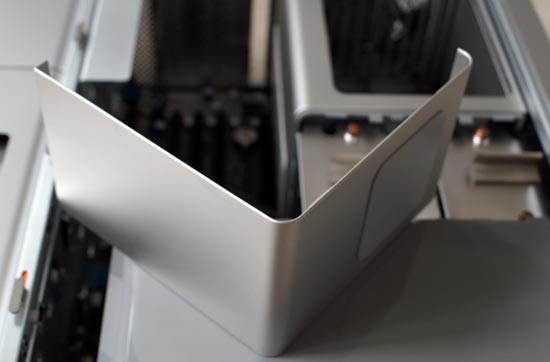
With the memory side of the heatsink cover unlatched, simply pull it away from the fan assembly being careful not to break the latches. After you've done this, the Xeon heatsinks should be exposed.


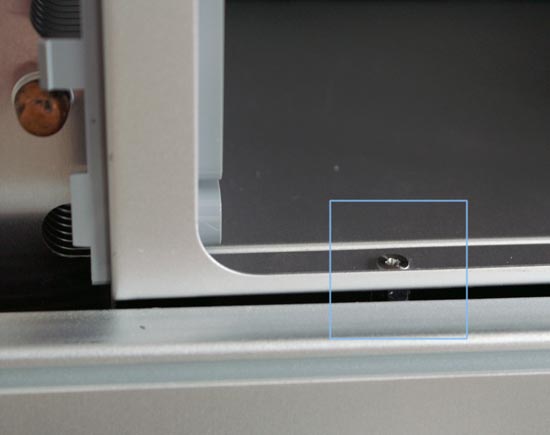
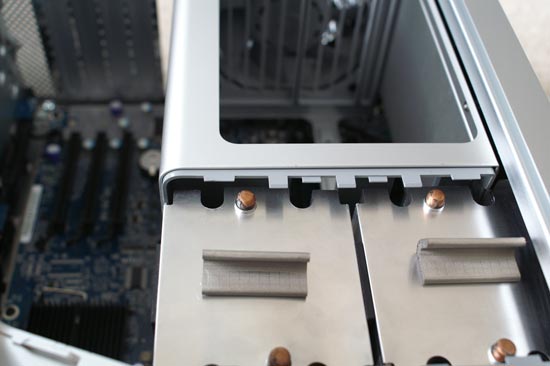
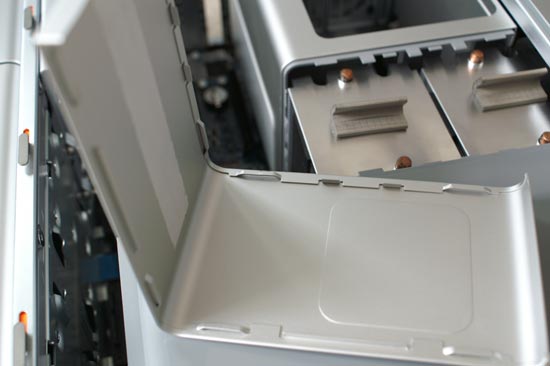
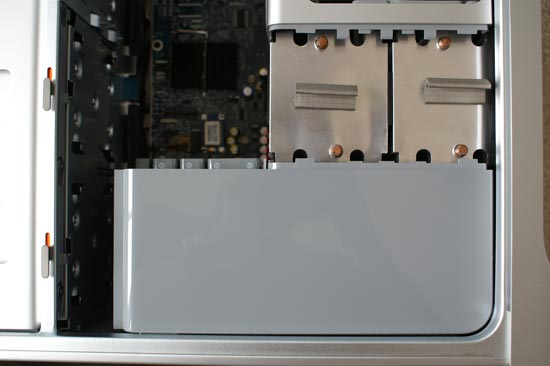








72 Comments
View All Comments
bobsmith1492 - Tuesday, September 12, 2006 - link
Well, thank you for the enlightenment. I will never use Vista now that I know I cannot use more than 64GB of RAM.blwest - Tuesday, September 12, 2006 - link
Who did that comment come from, something about never needing more than 64K? Was it Bill Gates?I already have customers that use Linux over MS because they utilize 64GB of ram TODAY. Even when Vista is released, they will still be using Linux.
bobsmith1492 - Tuesday, September 12, 2006 - link
Well, I've doubled the amount of ram in my _personal_ computer twice in about 5 years along with one upgrade of Windows (98-XP)... so, in 5 more, I'll have 8GB, 10 more: 32, and in about 12.5 years, I'll be up to 64GB, by extrapolation. :P Anyway, I don't expect Vista to last that long, so I guess I'm ok (heck, I'll use XP for a few more years anyway, no doubt - XP was out for a few years before I upgraded).As far as the 64GB of RAM, if you need that for your application, you probably wouldn't even dream of using a closed-source OS for it anyway, so I think the RAM limitation isn't really that relevant (maybe for servers...)
greylica - Tuesday, September 12, 2006 - link
Course the common user will not have to use that quantity of Ram, as far as I know, they are still using 256MB at nmaximun in order to run only apps for office/small production.Here in Brazil the most of them are using at maximun 512 MB of Ram, but when we think in a machine different, like a MAc, or then a graphic Workstation, or then an data seismic or a test evaluation machine, 64 GB in 5 years will be a cap, a limit.
Anyway Linux can save our souls to this switch Microsoft is trying to do again, and again...
A simpler crowd simulation in XSI can achieve 16 GB of Ram in a workstation...
Vista Premium can accept more than 4GB, course, but in the 32 bit usage, the same old 3GB switch is aplicable, but I don´t even imagine why they at the same tima reserve 4GB for the kernel, and limit Vista to 1/2 of the potential.
It´s a same old problem coming back again.
Even 2000 accepts PAE, but doesn´t serve for nothing, course they can give a patch, but, do they want ???
If a patch for ths issue is released, this topic can be sent to oblivion.
Microsoft, give us a patch to 3GB switch right now !!!!!!
mostlyprudent - Tuesday, September 12, 2006 - link
I have to agree with the first part of your post. I read the article and thought.."Why?". I have always understood the appeal of a Mac to be that you could upack it and get to work. If we start talking about running other OSs on a Mac or hacking software/drivers for better hardware supprt, then why pay the premium for a Mac?lopri - Tuesday, September 12, 2006 - link
Well, sort of.. Remember that now Mac is a PC with the ability to dual-boot between XP and OS X. Other than the anatomy description for CPU upgrading, I don't see anything Mac-specific about this article. You can replace the tested Mac with an equivalent workstation from Dell, HP, etc. and the end result would be the same. It's also very questionable how much appeal this article would have to an 'average' apple user - who wants a computer that just works, without worrying about upgrading or fixing, and prefers to use for creative works or entertainment. (This isn't my opinion, btw. I happened to read a few articles on Apple/Mac @DailyTech, and it's how Mac users described themselves) I totally understand this article is a sequel/finale to a previous article, but I think some people would agree with me. (If not, oh well.. :) )From this viewpoint, I'd like to make a comment that Anand's obsession on Apple (be it hardware or software) has been quite over-the-top already. Even though this article isn't really about something unique to Apple, he doesn't skip a single product that Apple produces. (I still can't believe he "reviewed" a mouse just because it's from Apple. There are many more superior and innovative mice in the market, you know.)
Whether it's his personal preference towards Mac/OS X or a business strategy to expand the readership of this site isn't clear to me. But I can't help but notice the imbalance and ask why.
Anand Lal Shimpi - Tuesday, September 12, 2006 - link
The point of the article was for users that want to run OS X as well as Windows XP, rounding out the performance comparison by showing what sort of XP performance you can expect out of the Mac Pro.As for our Mac coverage, we definitely don't review every Apple product that comes out, but the ones that we do focus on are those that are most interesting to the community. The vast majority of our content is still PC focused, but whenever there's a big Apple release we will do our best to cover it just as we do major releases on the PC side.
Take care,
Anand
JAS - Thursday, September 14, 2006 - link
PC = Personal Computer, regardless of whether it is running OS X or Microsoft Windows.Please continue with the Macintosh coverage, Anand. I appreciate the excellent work that you do, and even bought a Mac because of one of your reviews. What a fabulous computer.
Calin - Tuesday, September 12, 2006 - link
:)I'm sure Anand wants to expand the readership of his site to the 5% Mac users :)
(no offence, Anand) but I think this was more like a toy, that is getting better and better. "I bet I could use only this Mac for everything" could have been the idea of the first article, and in the end it seems the Macs were even better than that (whether by look and feel, ergonomy in user interface, invulnerability to almost all viruses/worms/... (the first Mac used by Anand was Power based), other reasons or a combination of all the above).
On another note, I wonder how well those new Macs will survive in the virus world, now that they now have the x86 processors
JAS - Thursday, September 14, 2006 - link
If you mean running Microsoft Windows on a Macintosh, then it is as susceptible to spyware and viruses as any other MS Windows computer. These problems are tied to the operating system, not the microprocessor. OS X is as secure running on Intel as it is on PowerPC chips.